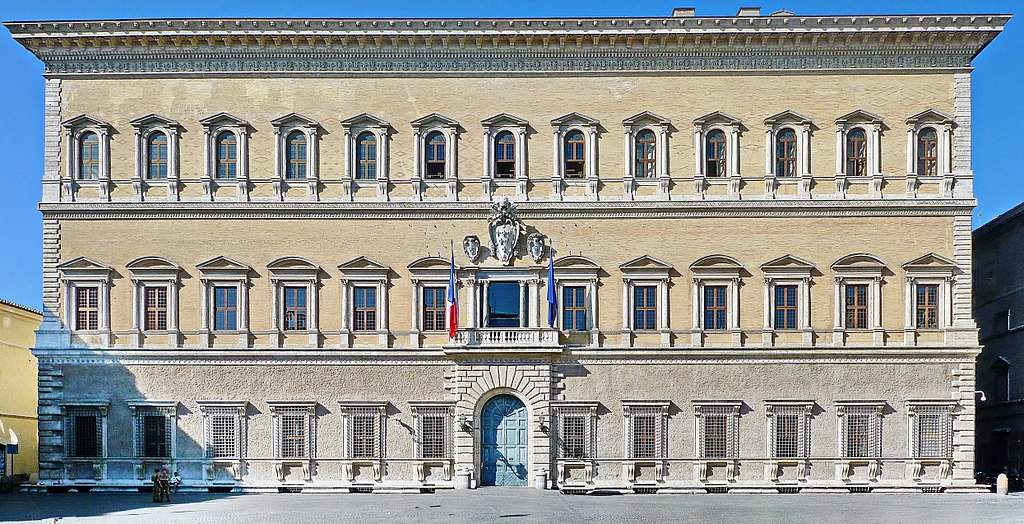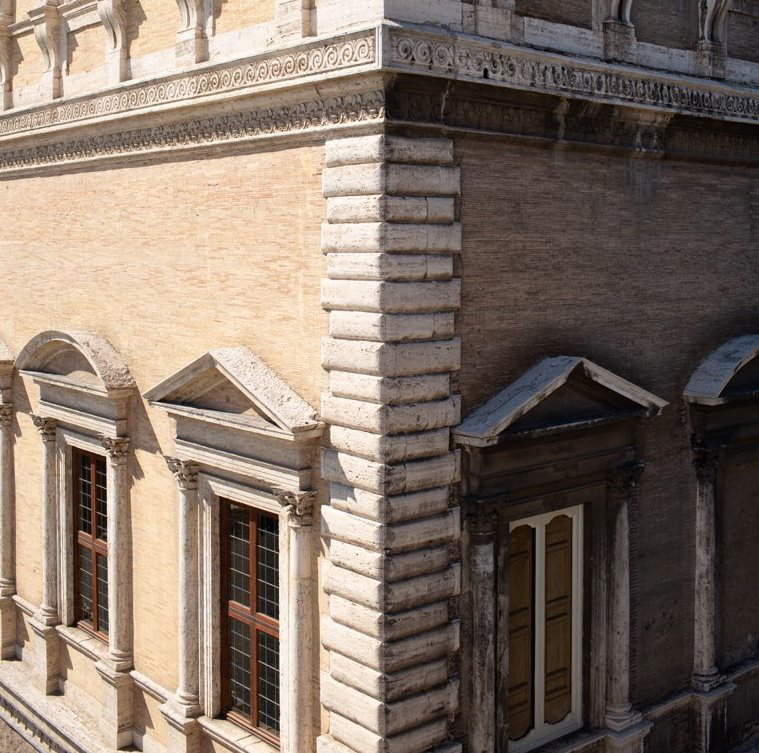Work is starting in Rome to restore the facades and roofs of Palazzo Farnese, home of the French Embassy in Italy and the �?cole française de Rome, with the aim of restoring the original appearance of the palace on which four great architects succeeded each other, namely Antonio da Sangallo the Younger (Florence, 1484 - Terni, 1546), Michelangelo Buonarroti (Caprese, 1475 - Rome, 1564), Jacopo Barozzi known as the Vignola (Vignola, 1507 - Rome, 1573) and Giacomo della Porta (Portezza, 1532 - Rome, 1602): Is one of the most important 16th-century painters in the capital.
It was 1513 when Antonio da Sangallo started the construction of the main facade, while the palace was already occupied by the owner, Cardinal Alessandro Farnese. In 1546, after the death of the first architect, Michelangelo carried on with the building site left unfinished by his predecessor, creating the cornice of the palace, modifying the large window of the main facade, and building the second floor of the inner courtyard. Beginning in 1550, Vignola participated in the edification of the facade on Via del Mascherone, and finally, in 1573, Giacomo Della Porta initiated the construction of the rear wing and then completed the facade facing the Tiber in 1589. Ledification of the facades of Palazzo Farnese thus continued throughout the 16th century. To the names of the four great architects who succeeded one another, it is necessary to add the names of the Palace’s tenants, represented on the facade by very specific symbols: the festoons, palms and oak of Pope Alexander VII Chigi; the ears of wheat of the Vasa dynasty to which Christina of Sweden, who stayed at the Palace, belonged; and the lily of the Farnese.
 |
| Farnese Palace. Ph. Credit |
The campaign that kicks off to begin is in continuity and aims to continue the previous interventions, in particular the one carried out on the occasion of the will concern the cleaning of the plaster, the consolidation of the stones and the revision of the roofing in ancient tiles. Piazza Farnese and on Via Giulia, the original designs of the 16th-century fixtures. The restoration of the travertine and brick face will take place at the same time as the overhaul of the Roman-style tile roofing. As for the color of the facades, the latter will be restored by means of a harmonizing patina that will make it possible to soften the leccessive contrast between the restored facade of Piazza Farnese and the side facades. Sampling and various samples will be taken to scientifically ascertain the composition of the original mortars and plasters, this in an effort to get as close as possible to the original work.
The work started on March 1, 2021, and is scheduled to end in 2025. The first phase is devoted to the restoration of the façade on Via dei Farnesi, the fixtures as well as the roofing on the slopes of that façade (site preparation has already started: the first stage of this phase will concern the start of the placement of the roofing and consolidation of the truss); the second phase will be devoted to the restoration of the facades (the start of the restoration of the facade on Via dei Farnesi is scheduled for July), fixtures, as well as the roofing on the slopes of Via del Mascherone; the third phase will be devoted to the maintenance of the main facade overlooking Piazza Farnese, the overhaul of the fixtures, as well as the restoration of the roofing. Finally, the fourth phase will focus on the restoration of the roofs on Via Giulia and the garden wall, as well as the roofs on the slopes of Via Giulia.
A total of 5.6 million euros have been invested to complete the restoration, co-financed by the French ministries of Europe and Foreign Affairs, and Higher Education, Research and Innovation. The construction site was designed to minimize as much as possible the impact on the neighborhood.The project of the restoration of the facades and roofs of Palazzo Farnese was born in 2017. The client of the works, the French Embassy and l�?cole française de Rome, promoted the project through constant dialogue with the local government. The commissioning of the works is the service des travaux et bâtiments français en Italie (STBI). It is ensured by theagency of Pierre-Antoine Gatier, Chief Architect of Historical Monuments and Inspector General of Historical Monuments. To ensure the conformity of the restoration strategies, a scientific committee composed of French and Italian experts met on several occasions in 2018, twice in 2019, and finally in 2020. The restoration is being scientifically monitored by the Soprintendenza Speciale Archeologia, Belle Arti e Paesaggio of Rome. The construction site will be started in March 2021.
The French embassy reports that the restoration campaign will also be an opportunity for the embassy itself and l�?cole française de Rome to enhance the historical and artistic heritage of Palazzo Farnese. To achieve this goal, various artists and researchers are invited to bring their contributions to the knowledge and appropriation of this important building. Online or in situ, the protagonists called by the Palace will allow the public to discover the palace in a new light, participate in the dissemination of knowledge around the monument, present the discoveries made during the works and reveal the “behind the scenes” of a restoration site, usually closed to the public. Throughout the restoration campaign, various artists will be invited to work directly on the palisades of the construction site to offer the public a contemporary reinterpretation of Palazzo Farnese and the works that have taken part in its history.
 |
| Palazzo Farnese. Ph. Credit Ch. Mantuano |
 |
| Rome, start of restoration of Palazzo Farnese, 16th century architectural masterpiece |
Warning: the translation into English of the original Italian article was created using automatic tools. We undertake to review all articles, but we do not guarantee the total absence of inaccuracies in the translation due to the program. You can find the original by clicking on the ITA button. If you find any mistake,please contact us.